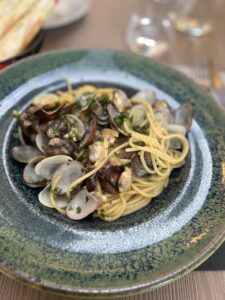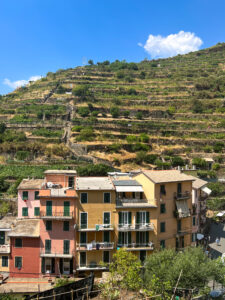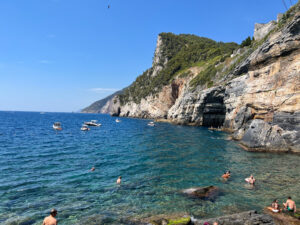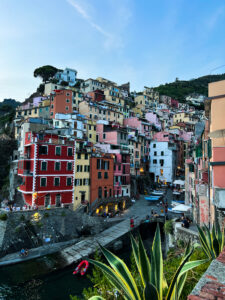
I visited Italy for the first time 11 years ago in what felt like the culmination of a decade of incessant determination, serendipity, blind faith, and unbelievable luck. The program director for a summer program for high school students somehow decided to take a chance and hire me based only on an email, and I got to spend the summer I was 21 (and then for part of the next summer, too) working my first-ever job as an RA in Rome. I got my first passport and headed to Europe for the first time.
I don’t know what it is that draws certain people to certain culture, like how my brother-in-law is the most enthusiastic Anglophile and how my friend Sophie loves all things French. For me, it was always, always Italy. I can’t quite express why. Sure, it’s the food and the history and the language and the beauty, but there’s something less tangible and easy to name that makes me contemplate just packing up and moving there roughly once per week. Even though I’ve never been to Lake Como or Cinque Terre before, arriving in Como this August after my journey through Switzerland felt like I was arriving to the home of a warm and hospitable friend who tells you to make yourself at home and means it. I’d been travelling just over a month at that point, and Italy felt like a reprieve from the constant puzzle of navigating cultures foreign to me. Here was a place I could relax and a place where, though I don’t speak the language, I felt like I understood things on a more fundamental level that made everything easier (which, of course, just means that simple confidence makes things feel easier).
I spent a night in Lake Como at a hostel that was very expensive, very crowded, and very nice. But I didn’t care much where I was staying because all I wanted was spaghetti alle vongole and real gelato for the first time in 10 years, and even though I’ve been declared lactose intolerant since the last time I had gelato in Italy, and even though it started raining on my dinner while I was eating outside, nothing could dampen my joy (or dairy intake).


I took a quick trip on the ferry to Bellagio the next day. The views of the Italian Alps from the ferry were what I’d hoped to see in Lake Lucerne—turns out they were waiting for me in Italy after all. Bellagio was far smaller and more glamourous than I’d imagined. As beautiful as it was, a couple of hours was enough for me. Even the souvenir shops were for a wealthier clientele than I can’t relate to, and it made me understand why celebrities vacation here. I took the train down to Naples to catch my connecting train to the main reason I’d decided to brave the heat of Italian August—Cinque Terre.
I worried Cinque Terre would be an overpriced and overcrowded letdown. I did not doubt it would be beautiful, but would I have to fight my way through an entitled and belligerent mass to glimpse it? I stayed in La Spezia, the nearest city to Cinque Terre and a much cheaper option than staying in one of the 5 villages. The name Cinque Terre doesn’t actually refer to one place—it means “5 lands” and refers to 5 villages that sit next to each other on seaside cliffs on the Italian Riviera in the Liguria region. There’s a train and a ferry that take you between them, or you can hike if you feel bold, and there are several other towns, like La Spezia, that are connected to the same train/ferry lines, too. I’d read blogs that warned me against staying in La Spezia, claiming it was not a place worth visiting and was only a last resort if you couldn’t afford to stay in the villages. I read that it was a working-class port city that had seen better days and that you wouldn’t want to walk alone here at night. And this is an example of why it’s important to remember that opinions on blogs are just that—opinions. I loved La Spezia. I loved that I felt like I’d found myself in a town full of locals who weren’t frantic to adjust their lifestyle to cater to tourists like me. And mostly, I adored Costello Hostel. The moment I arrived, the staff greeted me personally, learned my name, and remembered it, then they offered me free (and delicious) pasta they’d just made in the kitchen. There were just a few dorm rooms, so everyone got to meet everyone else. Everyone joins a WhatsApp group so they can share events and activities while staying there, and I genuinely felt I was missing out when I kept getting the messages after I left. It’s such a communal space that they don’t even have locks on the dorm doors (but don’t worry, they do have locks for your lockers). You feel like you’re in a very social friend-of-a-friend’s home who happens to have a lot of bunkbeds. This is everything a small hostel should be, and I highly recommend them.


I waited until morning to venture to Cinque Terre. I debated which village to start with, and I settled on Vernazza because someone in the hostel told me that the hike between Vernazza and Corniglia was nice, and I’d decided to devote the day to walking between the villages if it wasn’t too strenuous. When I emerged from the train station in Vernazza, I was suddenly in this absurdly beautiful and tiny village square surrounded by more colors than I had names for. The multistoried homes were built into the hillsides overlooking the sea, and they looked like they’d been crafted by hand and had been peering over the rock edges for centuries. The only people in sight were the ones setting up their vegetable booths for the morning market. This wasn’t the glamour of Bellagio—this was a rugged beauty that felt far more real. I couldn’t understand where all the tourists were. I’m still left astonished at how waking up even slightly early anywhere in Europe (not weirdly early—I mean even like 8am) ensures a near private experience, even in the most touristy places.

I wandered Vernazza for a while before beginning what I thought would be a leisurely walk to Corniglia. It was not. The leisurely walk turned out to be a 2-hour rigorous climb up and down a mountain so tall that my legs felt like they might fall off and tumble down the mountainside without me. But I was too enchanted by the views and committed to the endeavor to stop. I made it to Corniglia, and the crowds still hadn’t arrived. One the walk between Corniglia and Manarola, I felt such vertigo from how narrow, high, and steep my path through the mountainside vineyard was that I had to hold onto the tiny grape tree branches to make sure I didn’t topple over. They grow grapes here in these vertical vineyards that you should do yourself a favor and Google now. It’s sorcery, I think. The glimpses of each upcoming town from the hilltops made it impossible not to push on. I kept deciding that the town I was in was FOR SURE the most beautiful until I got to the next one and decided that actually IT was the most beautiful. The final hiking stretch I did was the one from Manarola to Riomaggiore, and at one hour, it was supposed to be the shortest. I assumed this meant it would be the easiest. It was actually stairs. Just stairs. Uneven stone ones that took you straight up a mountain and then straight down it. For an hour. I thought I might pass out and let someone carry me the rest of the way. When I finally got to Riomaggiore, the crowds had arrived in full force, and I’d walked for 6 hours in what I found out later was a heat warning. My Fitbit told me I walked up 222 flights of stairs (and down that many too), and that felt accurate, and though I was in pain for 2 days after, I’d do it again without hesitation.




The next day I visited the last town, Monterosso, which is the largest of them, then I took a ferry to Porto Venere, which isn’t one of the official 5 towns but is no less beautiful. I met an elderly man in Porto Venere who was reading his “English in 5 Minutes a Day” book while waiting for his lunch to arrive. I caught a glimpse of some paintings he had as he was flipping through a folder, and I asked if he’d done those. He showed me his whole sketch book—painting after gorgeous painting of the town. He’d lived there in the bay for his entire life, and he has a little gallery in the nearby town of Lerece. He doesn’t do online sales or have an online presence from what I can tell—he just lives there peacefully in his little town, painting, and eating fried fish while he teaches himself English in 5 minutes per day. Half of our conversation was through Google translate, and he had to put his glasses on to see my phone. He looked absolutely delighted, and I feel like he could teach us all an important lesson about the right way to be happy.
It never felt less surreal that the photos of this place had not been photoshopped or exaggerated. In my experience, Italy does this—manages to surpass the expectations you try to talk yourself out of having.


When I left Cinque Terre, I had a few hours layover in Venice before catching my next train. It was the only place on my trip so far that I’d been to before. After that first summer of working in Rome, I’d taken every penny I’d earned and spent it on 4 nights/5 days in Venice. It was the first place in Europe that I ever solo-traveled. All I did during those 5 days was wander aimlessly, feeling like I was dreaming. I never even took a day tour or did any specific activities—I didn’t have a smart phone, and I don’t know if I knew things like free tours existed. It didn’t matter—there was nothing I’d rather have done than wander. During my few hours layover in Venice, I accidentally happened upon a café that I immediately remembered. I’d gone there every day of my stay 11 years ago because they had this Nutella coffee drink that I was obsessed with. It’s fascinating to me what memories stick with us the hardest. Such small things can bring us enormous joy if we let them.
This post may contain affiliate links which earn me a small commission from bookings at no extra cost to you. Thank you for reading and supporting my blog!



